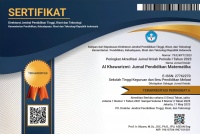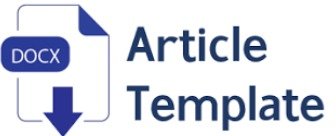KEMAMPUAN REPRESENTASI DALAM MENYELESAIKAN MASALAH SISTEM PERSAMAAN LINEAR TIGA VARIABEL
DOI:
https://doi.org/10.46368/kjpm.v2i1.614Abstract
Abstract: This study aims to analyze the representation of students in solving the problem of the Three Variable Linear Equation System. The method used is descriptive qualitative. The subjects were students of class X. 1 IPA and X. 1 IPS MAIB Kotabaru. The results showed that students who were able to solve SPLTV problems by changing the problems that were started from words of mathematical symbols were 50% for the high category, 0 for the medium category, and 50% for the low category. Students who are able to solve SPLTV problems by changing the problems starting from the mathematical symbols image are 27% for the high category, 0 for the medium category, and 73% for the low category. Meanwhile students who were able to solve SPLTV problems using the cramer method were 77% for the high category, 0% for the medium category, and 23% for the low category.
Keywords: Representation, SPLTV
Â
Abstrak: Penelitian ini bertujuan untuk menganalisis representasi peserta didik pada penyelesaian masalah Sistem Persamaan Linear Tiga Variabel. Metode yang digunakan yaitu deskriptif kualitatif. Subyeknya yaitu siswa kelas X. 1 IPA dan X. 1 IPS MAIB Kotabaru. Hasil penelitian menunjukkan bahwa siswa yang mampu menyelesaikan masalah SPLTV dengan mengubah permasalahan yang diawali dari kata-kata kesimbol matematika yaitu sebanyak 50% untuk kategori tinggi, 0 untuk kategori sedang, dan 50% untuk kategori rendah. Siswa yang mampu menyelesaikan masalah SPLTV dengan mengubah permasalahan yang diawali dari gambar kesimbol matematika yaitu sebanyak 27% untuk kategori tinggi, 0 untuk kategori sedang, dan 73% untuk kategori rendah. Sedangkan siswa yang mampu menyelesaikan masalah SPLTV dengan menggunakan metode cramer yaitu sebanyak 77% untuk kategori tinggi, 0% untuk kategori sedang, dan 23% untuk kategori rendah
Kata kunci: Representasi, SPLTV
References
Cahyani, Murti. (2017). Modul Pengayaan Matematika. CV Grahadi. Surakarta.
Hikmah, N. (2016). Peningkatan Hasil Belajar Matematika tentang Penjumlahan dan Pengurangan Bilangan Bulat Melalui Alat Peraga Mistar Bilangan Pada Siswa Kelas IV SDN 005 Samarinda Ulu. Jurnal Pendas Mahakam, 1(1), 80-85
Marjono, Marsudi. (2012). Aljabar Linier. Malang : Universitas Brawijaya Press (UB Press.
NCTM. (2000). “Principles And Standards for School Mathematicsâ€.Reston, Va. United States of America.
Nurintan, Rizki. (2019). “Analisis Kemampuan Representasi Siswa Kelas VIII SMP Al Fattah Semarangâ€. Jurnal Penelitian Didaktik Matematika, 3(1), 23 – 36
Sinaga, Bornok. (2017). “ Matematika SMA/MA/SMK Kelas Xâ€.Pusat Kurikulum Dan Perbukuan, Balitbang, Kemendikbud. Jakarta.
Suparno. 2017. Matematika SMA/MA/SMK/MAK Kelas X. Intan Pariwara
Sugiyono. 2015. Metode Penelitian Pendidikan. ALFABETA. Bandung
Sugiyono. (2018). Metode Penelitian Kuantitatif, Kualitatif, dan R&D. Bandung: ALFABETA
Downloads
Published
How to Cite
Issue
Section
Citation Check
License
Authors who publish with this journal agree to the following terms:
1. Authors retain copyright and grant the journal right of first publication with the work simultaneously licensed under a Creative Commons Attribution License that allows others to share the work with an acknowledgement of the work's authorship and initial publication in this journal.
2. Authors are able to enter into separate, additional contractual arrangements for the non-exclusive distribution of the journal's published version of the work (e.g., post it to an institutional repository or publish it in a book), with an acknowledgement of its initial publication in this journal.
3. Authors are permitted and encouraged to post their work online (e.g., in institutional repositories or on their website) prior to and during the submission process, as it can lead to productive exchanges, as well as earlier and greater citation of published work.






